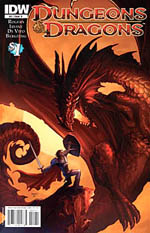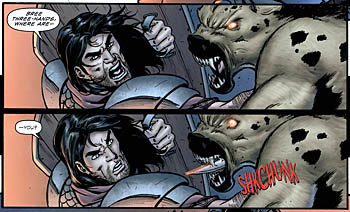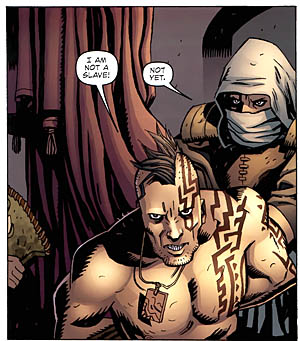 Written by John Rogers and Alex Irvine
Written by John Rogers and Alex Irvine
Art by Andrea Di Vito and Peter Bergting
24 pages, color
Published by IDW
I have a confession to make: about 25 years ago, I was a big Dungeons & Dragons geek. Played it all the time with friends, read the novels and comics, even helped maintain one of their official areas on a computer network back in the day. But 15 years ago, I fell away from it all and I haven’t come into much contact at all with the game or products since then. So when a copy of Dungeons & Dragons #0 ended up in my mailbox, well, I couldn’t help but get curious. I’d loved the comics by Jeff Grubb, Rags Morales, Dan Mishkin, Jan Duursema, and Tom Mandrake that DC had published many years ago. Could this be my new "gateway drug" back inside?
 Dungeons & Dragons #0 has two short stories that are meant to lure readers into their upcoming Dungeons & Dragons ongoing series, as well as Dark Sun mini-series. The first, by John Rogers and Andrea Di Vito, could best be described as fantasy by the numbers. The thief who stops during battles to loot the bad guys, the dwarf who gets excited about combat, the mysterious elf who is, erm, mysterious. There’s even mentions about how dungeons are full of mazes and twisty passageways. I hate to say it but this reminds me less of an actual story, and more of reading a dramatization of a group of friend’s latest gaming session. It’s not bad, but it’s not terribly good either. It’s by the book, no-surprises writing. Di Vito’s art is similarly inoffensive; he’s come along way since his CrossGen days, with rounded features and forms being drawn, but it’s utterly average and slightly forgettable.
Dungeons & Dragons #0 has two short stories that are meant to lure readers into their upcoming Dungeons & Dragons ongoing series, as well as Dark Sun mini-series. The first, by John Rogers and Andrea Di Vito, could best be described as fantasy by the numbers. The thief who stops during battles to loot the bad guys, the dwarf who gets excited about combat, the mysterious elf who is, erm, mysterious. There’s even mentions about how dungeons are full of mazes and twisty passageways. I hate to say it but this reminds me less of an actual story, and more of reading a dramatization of a group of friend’s latest gaming session. It’s not bad, but it’s not terribly good either. It’s by the book, no-surprises writing. Di Vito’s art is similarly inoffensive; he’s come along way since his CrossGen days, with rounded features and forms being drawn, but it’s utterly average and slightly forgettable.
 It’s the back-up story by Alex Irvine and Peter Bergting that stands out a bit, a prelude to the upcoming Dark Sun mini-series. Maybe it’s because the Dark Sun world is a deliberate step away from average fantasy, but this feels much more interesting. It’s funny, because Irvine’s story isn’t terribly substantial or out of the ordinary, but it feels much more natural and wasn’t written as a series of cliche lines. The ideas of slavery and caste positions are a much easier hook for the reader, and I’d be interested in seeing more of Irvine’s story. The big star of this entire issue, though, is Bergting. I like his slightly angular faces, the thick blacks used for hair, and the jagged tattoos drawn all over Grudvik. It has a genuine style and voice of its own, and Bergting is an artist that will go places.
It’s the back-up story by Alex Irvine and Peter Bergting that stands out a bit, a prelude to the upcoming Dark Sun mini-series. Maybe it’s because the Dark Sun world is a deliberate step away from average fantasy, but this feels much more interesting. It’s funny, because Irvine’s story isn’t terribly substantial or out of the ordinary, but it feels much more natural and wasn’t written as a series of cliche lines. The ideas of slavery and caste positions are a much easier hook for the reader, and I’d be interested in seeing more of Irvine’s story. The big star of this entire issue, though, is Bergting. I like his slightly angular faces, the thick blacks used for hair, and the jagged tattoos drawn all over Grudvik. It has a genuine style and voice of its own, and Bergting is an artist that will go places.
Part of what I liked about the old DC/TSR comics back in the day was that the characters in addition to the plots were interesting, to say nothing of some attractive art. I didn’t get that feeling at all with the lead story by Rogers and Di Vito, unfortunately, but Irvine and Bergting are showing promise in that direction. This comic wasn’t the welcome return to the game and worlds that I once loved that I’d hoped for. But I will take a look at the Dark Sun mini-series in January 2011 when it shows up, because that has a lot of potential. It’s a half-victory, which with just a dollar price tag, isn’t too bad. I just wish both halves of the comic were this fun. When a willing audience isn’t ready to immediately jump on for more, it’s time to take a closer look at what is and isn’t working.
